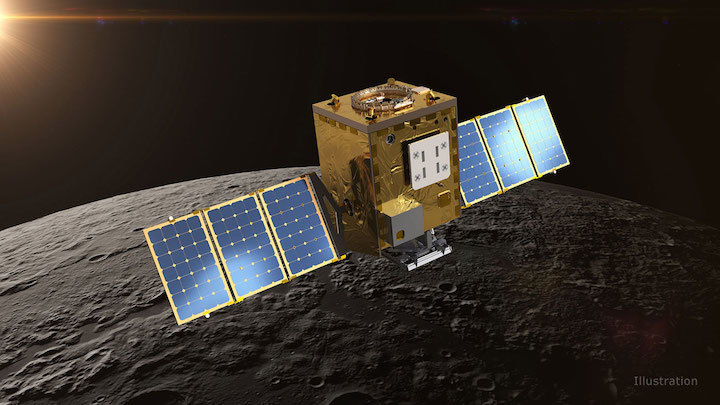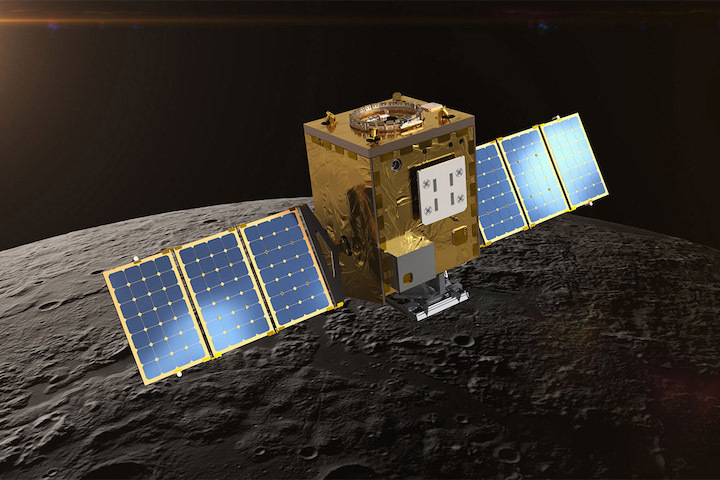4.12.2020

Peering into the Moon's permanently shadowed regions, Lunar Trailblazer will detect signatures of water ice in reflected light, and it will pinpoint the locations of micro-cold traps less than a football field in size. Credit: Lockheed Martin
Producing maps to locate ice or water trapped in rock at the Moon's surface, Lunar Trailblazer will help support NASA's efforts to establish a sustainable presence on the Moon.
A small-satellite mission to understand the lunar water cycle - detecting and mapping water on the lunar surface in order to investigate how its form, abundance, and location relate to geology - has received NASA approval to proceed with the next phase of its development.
On Nov. 24, the Lunar Trailblazer, a mission selected under NASA's Small Innovative Missions for Planetary Exploration (SIMPLEx) program, passed its Key Decision Point-C (KDP-C) milestone, obtaining agency-level endorsement to begin final design of hardware and build. The milestone also provides the project's official schedule and budget determination.
"Lunar Trailblazer will confirm whether water on the Moon is tightly bound in crystalline rock, as recently suggested byNASA's SOFIA (Stratospheric Observatory for Infrared Astronomy) observations, or loosely bound and mobile as a function of temperature," said Thomas Zurbuchen, associate administrator for science at the agency's headquarters in Washington. "This SIMPLEx mission bolsters our portfolio of targeted science missions designed to test pioneering technologies while reducing overall costs using new streamlined processes."
Producing the highest-resolution basemaps to locate ice or water trapped in rock at the Moon's surface, Lunar Trailblazer will help support NASA's Artemis program, which includes establishing a sustainable presence on the Moon by the end of the decade and preparing for crewed missions to Mars.
"We're excited to help answer big planetary science questions with a small satellite by making the new maps of water on the Moon," said Bethany Ehlmann, the mission's principal investigator, of Caltech. "Given the importance of water on the Moon for future robotic and human missions, Lunar Trailblazer will provide critical basemaps to guide future exploration."
Peering into the Moon's permanently shadowed regions, Lunar Trailblazer will detect signatures of ice in reflected light, and it will pinpoint the locations of micro-cold traps less than a football field in size. Collecting measurements at multiple times of day over sunlit regions, the mission will help scientists understand whether the water signature on the illuminated surface changes as the lunar surface temperature changes by hundreds of degrees over the course of a lunar day.
"Lunar Trailblazer will vastly advance our understanding of water cycles on airless bodies like the Moon," said Lori Glaze, director of NASA's Planetary Science Division at the agency's headquarters in Washington. "By measuring both direct light and low levels of terrain-scattered light, Lunar Trailblazer will generate comprehensive maps of surface water ice, even in the Moon's darkest regions."
Selected in 2019, Lunar Trailblazer is the second mission from the current round of programs to receive confirmation and plans to deliver its flight system in October 2022, with a launch currently planned for February 2025. The Janus mission received its confirmation in early September 2020 and will investigate the formation and evolution of small, deep-space "rubble pile" asteroids. The Escape and Plasma Acceleration and Dynamics Explorers (EscaPADE) mission is still in formulation, with its KDP-C planned for summer of 2021.
"Lunar Trailblazer has a talented, multi-institutional team whose collective effort resulted in a successful formulation phase and confirmation review," said Calina Seybold, Lunar Trailblazer Project manager, at NASA's Jet Propulsion Laboratory. "I am thrilled that the team has earned the privilege of continuing to our final design and fabrication phase."
For information on NASA's Lunar Trailblazer mission, visit:
https://trailblazer.caltech.edu/
For information on NASA's small satellite activities, visit:
https://www.nasa.gov/smallsat-institute
Lunar Trailblazer is managed by NASA's Jet Propulsion Laboratory (JPL) in Southern California as part of the Solar System Exploration Program at NASA Headquarters in Washington and guided by agency priorities and the Decadal Survey process of the National Academy of Sciences. Managed for NASA by Caltech in Pasadena, California, JPL also provides system engineering and mission assurance as well as navigation. Lockheed Martin provides the spacecraft and integrates the flight system, under contract with Caltech.
SIMPLEx mission investigations will be managed by the Planetary Missions Program Office at NASA's Marshall Space Flight Center in Huntsville, Alabama as part of the Solar System Exploration Program at NASA Headquarters in Washington. The program conducts space science investigations in the Planetary Science Division of NASA's Science Mission Directorate at NASA Headquarters, guided by NASA's agency priorities and the Decadal Survey process of the National Academy of Sciences.
Quelle: NASA
----
Update: 7.12.2020
.
UCF Researcher Part of New NASA Mission to Map Water on Moon
The Lunar Trailblazer Mission will create high-resolution maps, which will be important for crewed and robotic missions to the moon.

Lunar Trailblazer Illustration courtesy of Lockheed Martin.
NASA today gave a team of researchers the green light to begin building instruments that will be launched on a satellite to scan and create high-resolution maps of water on the moon.
In June 2019, NASA selected the Lunar Trailblazer mission, along with three other proposed missions, for further study under its Small Innovative Missions for Planetary Exploration (SIMPLEx) program. Today, NASA gave the international team, which includes UCF planetary geologist Kerri Donaldson Hanna, the go ahead to get ready for launch in 2025.
“There have been a lot of studies recently indicating there is water on the moon and now for the first time we’ll actually be able to identify water’s unique spectral signature with our instruments and get a better idea of whether its water, water ice or hydroxyl [compound of hydrogen and oxygen] based on that spectral signature and the measured surface temperatures,” says Donaldson Hanna, a co-investigator on the mission. “Water is an important resource for future astronauts and robotic missions to use for anything from hydration to fuel.”
Caltech planetary sciences Professor Bethany Ehlmann is leading the science portion of mission while the Jet Propulsion Lab in California will manage the flight mission for NASA. Lockheed Martin is providing the spacecraft. JPL is providing the High-resolution Volatiles and Minerals Moon mapper, a visible-shortwave infrared imaging spectrometer, and the University of Oxford is providing the Lunar Thermal Mapper, a thermal infrared imaging radiometer. The instruments will be used to scan the moon from a height of about 62 miles.
Once the satellite’s solar panels are fully extended, it will measure about 11½ feet long. The satellite will spend more than a year orbiting the moon collecting data.
Donaldson Hanna is a co-investigator working with the mission and an assistant professor of physics at UCF. She is tasked with making precise measurements of lunar light to better understand the geology and composition of the moon’s surface. Objects can emit their own light beyond our visible spectrum, and this infrared light is a product of surface temperature as well as composition. A thermal imager such as on this mission can measure emitted infrared light at select wavelengths, and Donaldson Hanna is fine-tuning these channels to reveal the moon’s composition.

Once the satellite is launched, Donaldson Hanna and her team of undergraduate and graduate students at UCF will focus on analyzing the data collected to determine the composition of parts of the moon.
As a graduate student at Brown University, Donaldson Hanna was a science team member of the Diviner Lunar Radiometer Experiment on board NASA’s 2009 Lunar Reconnaissance Orbiter and the Moon Minerology Mapper on board India’s 2008 Chandrayaan-1 mission. Donaldson Hanna’s contributions on Diviner helped produce the first compositional maps of the moon’s rocks and soil based on its thermally emitted radiation. The Moon Minerology Mapper discovered water on the moon, generated mineralogical maps of the moon, and was included on India’s first lunar spacecraft.
“It’s kind of a dream to see work you did as a graduate student and postdoctoral researcher push forward,” she says. “Early in my career as a graduate student, the Constellation program was shut down and going back to the moon seemed so far away … but some of us persevered and now with Artemis ramping up and all these new instruments coming online, well it’s a very exciting time to be working in lunar science again.”
The Lunar Trailblazer map is projected to show tiny amounts of water and of hydroxyl on the sunlit side of the moon and at the poles. Trailblazer will also peer into shadowed craters to map water ice deposits. Aside from helping investigators understand how water works on an airless body like the Moon, the maps will also be useful for planning future human and robotic missions to the moon.
“We’re excited to pioneer NASA’s use of small satellites to answer big planetary science questions,” says Ehlmann. “By making detailed maps of water on the moon we expect Trailblazer will hugely advance our understanding of something we don’t fully understand: the water cycle on airless bodies. Given the importance of water on the moon for future robotic and human missions, the Lunar Trailblazer mission team is excited to provide the critical base maps that will guide this future exploration.”
Donaldson Hanna has a bachelor’s degree in space sciences from the Florida Institute of Technology, and a master’s degree and doctorate in geological sciences from Brown University. Donaldson Hanna also conducted research within the atmospheric, oceanic and planetary physics sub-department at the University of Oxford before receiving a UK Space Agency Aurora Research Fellowship to continue her research at Oxford. While at Oxford, she held a junior research fellowship at Christ Church College and was awarded the early career Winton Capital Geophysics Award from the Royal Astronomical Society.
Her research focuses on understanding the formation and evolution of airless bodies such as the moon, Mercury, Mars’ moons, and asteroids. She pursues this research interest using several methods including telescopic observations, making laboratory measurements of airless body analogues to compare with the remote sensing observations, and developing space instrumentation for observing airless bodies. She also participated in NASA’s OSIRIS-REx mission.
Quelle: University of Central Florida
